Lots of developments at NWCW with the flowering of Greater knapweed (Centaurea scabiosa); profuse Common figwort (Scrophularia nodosa); Hemp agrimony (Eupatorium cannabinum); Wild clary (Salvia verbenaca); Marsh bedstraw (Galium palustre) and Broom (Cytisus scoparius). Insects were also about with Rhagonycha fulva beetles and Tabanus bovinus horse-flies.
This blog may help people explore some of the 'hidden' issues involved in certain media treatments of environmental and scientific issues. Using personal digital images, it's also intended to emphasise seasonal (and other) changes in natural history of the Swansea (South Wales) area. The material should help participants in field-based modules and people generally interested in the natural world. The views are wholly those of the author.
Sunday, 3 July 2016
Seeing the Changes 1093
Lots of developments at NWCW with the flowering of Greater knapweed (Centaurea scabiosa); profuse Common figwort (Scrophularia nodosa); Hemp agrimony (Eupatorium cannabinum); Wild clary (Salvia verbenaca); Marsh bedstraw (Galium palustre) and Broom (Cytisus scoparius). Insects were also about with Rhagonycha fulva beetles and Tabanus bovinus horse-flies.
Subscribe to:
Post Comments (Atom)
It's All Downhill Now
The snowline is climbing in the French Alps. This has resulted, thus far, in the closure of 186 ski resorts. This figure is like...

-
I n the UK and US, a pparently popular and successful vegan/vegetarian restaurants are reportedly closing or adding meat to their menus ( ...
-
Early ripening fruit may seem convenient but some folk think it confirms environmental stress. There's also a possibility th...








%20mating%20NWCW.jpg)


No comments:
Post a Comment